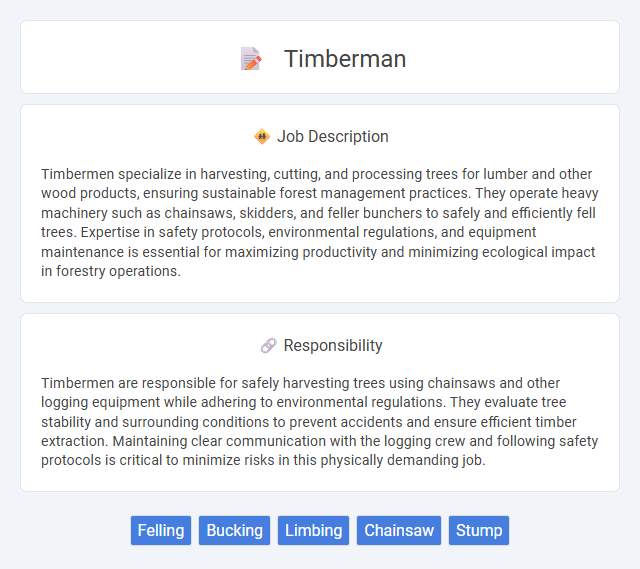
Timbermen specialize in harvesting, cutting, and processing trees for lumber and other wood products, ensuring sustainable forest management practices. They operate heavy machinery such as chainsaws, skidders, and feller bunchers to safely and efficiently fell trees. Expertise in safety protocols, environmental regulations, and equipment maintenance is essential for maximizing productivity and minimizing ecological impact in forestry operations.
Individuals with strong physical endurance and a high tolerance for outdoor work conditions are likely to be well-suited for a timberman job. Those who are comfortable with manual labor, including handling heavy equipment and working in potentially hazardous environments, may find this occupation appropriate. People prone to respiratory issues or with limited physical strength might face challenges in adapting to the demands of this profession.
Qualification
Timbermen must possess strong physical fitness and expertise in tree identification, felling techniques, and safety protocols to efficiently and safely harvest timber. Certification in chainsaw operation, first aid, and environmental regulations enhances their qualifications and job performance. Practical experience combined with knowledge of forestry management and wildlife conservation ensures sustainable and responsible timber harvesting.
Responsibility
Timbermen are responsible for safely harvesting trees using chainsaws and other logging equipment while adhering to environmental regulations. They evaluate tree stability and surrounding conditions to prevent accidents and ensure efficient timber extraction. Maintaining clear communication with the logging crew and following safety protocols is critical to minimize risks in this physically demanding job.
Benefit
Timberman jobs likely offer the benefit of physical fitness due to constant outdoor work and manual labor. There is a probable advantage of job stability, given the ongoing demand for timber and forestry products. Income potential may be enhanced by opportunities for overtime and specialized skills in safe tree felling and equipment handling.
Challenge
Timberman jobs often involve physically demanding and hazardous conditions, increasing the probability of encountering challenges such as difficult terrain, unpredictable weather, and the risk of injury. The complexity of safely operating heavy machinery and accurately cutting trees requires precision and attention, likely testing an individual's skill and endurance. Adapting to fluctuating environmental factors and maintaining safety standards remain probable ongoing obstacles in this profession.
Career Advancement
Timberman careers offer significant opportunities for advancement through skill acquisition in tree felling, pruning, and safety protocols. Mastery of advanced equipment like chainsaws and aerial lift platforms positions timbermen for supervisory roles or specialized tasks such as forestry management. Continuous training in arboriculture and certifications in occupational safety enhance prospects for leadership roles and higher-paying positions within forestry and logging industries.
Key Terms
Felling
Timberman experts in felling expertly cut and safely bring down trees using chainsaws, axes, and heavy machinery. Precision in selecting the correct felling direction minimizes environmental impact and hazards to workers. Mastery of tree biology and terrain assessment ensures efficient timber harvesting while preserving forest health.
Bucking
Timberman bucking specialists expertly cut felled trees into precise logs, optimizing wood quality and minimizing waste. Using advanced chainsaws and measuring tools, they ensure accurate log lengths that meet industry standards for sawmills and pulpwood processing. Their skill in identifying defects and adjusting cuts directly impacts timber yield and overall profitability in forestry operations.
Limbing
Timberman jobs specializing in limbing involve the precise removal of branches from felled trees to ensure safe handling and transport. Skilled use of chainsaws and hand tools is essential for efficiently stripping limbs while minimizing wood waste and maintaining tree integrity for lumber processing. Safety protocols and knowledge of tree anatomy are critical to prevent injuries and optimize workflow in forestry operations.
Chainsaw
Timbermen rely heavily on chainsaws to efficiently fell trees, trim branches, and cut logs with precision and speed. Mastery in chainsaw maintenance, safety protocols, and handling techniques is critical to minimize risks and ensure productivity in forestry operations. High-performance chainsaws, equipped with advanced features such as anti-vibration systems and automatic oilers, significantly enhance the timberman's capacity to work in diverse and challenging environments.
Stump
Timbermen specialize in cutting down trees, with a critical focus on stump removal to prepare land for construction or reforestation. Efficient stump extraction requires knowledge of specialized equipment such as stump grinders and controlled explosives, ensuring minimal environmental impact. Proper stump management prevents regrowth, reduces pest infestations, and promotes soil health in forestry operations.
 kuljobs.com
kuljobs.com